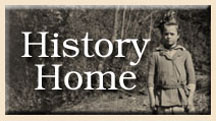

Health and Family in Southern Appalachia
Like every thing else in Southern Appalachia during the late nineteenth to early twentieth century, health care standards varied from place to place. Those who lived in or near one of the region’s larger towns enjoyed reasonably good (if not excellent) health care. Those who lived in one of the region’s more isolated corners, however, often did not. In this essay, we will explore the health care standards of the latter communities--those that seldom benefited from the presence of trained medical professionals, and who thus relied primarily on folk remedies when attempting to treat disease. Such communities were, contrary to popular belief, a rarity in Southern Appalachia; and yet they did exist. Gatlinburg, Tennessee, the locus of the Pi Beta Phi Settlement School, was just such a community.
Let us, then, begin our explanation of Southern Appalachian health care standards with a discussion of maternity. Pre- and post-natal care was virtually unknown to the Southern Appalachian mountaineers. Mothers carried on with life as usual right up until the moment of delivery, gave birth in their own homes with the assistance of a “granny women” (midwife), and then returned to house and farm work as soon as they were well enough to stand and walk about. Babies made do without immunizations, regular checkups, or a special diet (malnutrition was a common problem among mountain children), and birth defects such as clubbed feet and poor eyesight went mostly untreated. As Pi Beta Phi Settlement School nurse Marjorie Chalmers put it years later, “where money was scarce and trips into town almost never undertaken, [and] where doctors were called only as a last resort,” birth defects were often viewed as “the ‘will of God’.” “Many who were deeply religious,” she continued, “considered it almost a sacrilege to question that will. . . . It would be, in effect, a doubting of God’s judgment and kindness.” Needless to say, infant mortality rates were excessively high in the region’s more isolated corners.
For those who survived infancy, childhood posed its own perils. Burns were an all-too-common occurrence among toddlers, for nearly every home featured an open fireplace crowded with cast iron (and very hot) skillets, cauldrons, and other utensils. Farm labor contributed to numerous injuries among older children--“those little rascals,” Chalmers wrote, “handle axes as long as themselves”--as did rough-and-tumble play. Because of their tendency to roam the fields and woodlots and wade in the creeks surrounding their homes, mountain children were prone to encounter a host of wild animals and parasitic organisms. Black bears, for example, were powerful and unpredictable, and could easily maul or kill a small child. And poisonous snakes were known to curl up in the dark corners of henhouses, barns, and even homes, delivering a (potentially) lethal dose of venom to the small hand unfortunate enough to disturb its slumber. More serious, however, was hookworm--an intestinal parasite known to lurk in the damp soils adjacent to creeks and outhouses. As their name suggests, hookworms burrow into the exposed skin of humans and other animals--usually the soles of the feet--and attach themselves to the intestinal wall of their host. There, they feed on blood, and if enough of them are present, may cause anemia (and hence a host of developmental problems such as low weight, impaired cognitive ability, and in extreme cases, mental retardation).
Adult life was, of course, no less hazardous. Routine chores such as cutting firewood and plowing fields carried with them considerable risk, for the falling tree and the kicking mule were capable of inflicting serious, and sometimes fatal, injuries. Of course, in the septic world of the Southern Appalachian mountaineer, an injury need not be serious to be fatal. Sanitation and personal hygiene standards were abysmal by any standard, so much so that a serious infection might arise from contact with everyday objects. Nurse Chalmers learned this herself in the 1940s, acquiring a gangrenous infection from one of her Gatlinburg patients that necessitated the amputation of her left thumb.
Detrimental as accidents, poor nutrition, animals, and parasitic organisms were to the health of the Southern Appalachian mountaineers, however, they all paled in comparison to infectious disease. Among the very young, childhood diseases such as measles, mumps, diphtheria, whooping cough, and scarlet fever, among others, took a grim yearly toll. As late as December 1916, Pi Beta Pi representative Elizabeth A. Helmick noted sadly that diphtheria had “caused a large number of deaths among the children [living in the vicinity of Gatlinburg, Tennessee], especially at the [isolated] Sugar Lands” community. Adults and the elderly were by no means immune to infections. Influenza was a constant visitor to the isolated homesteads of Southern Appalachia, as were trachoma, a bacterial illness that caused blindness, and pneumonia. Of course, few diseases were more feared than smallpox, a viral infection that, if it did not kill the patient outright, left him or her horribly disfigured for life. Unfortunately, there were too few doctors available to immunize the healthy and treat the sick, leaving medical care in the hands of “herb doctors” or “granny women.” These pseudo-doctors--mostly elderly women who had been trained by their mothers--were well-intentioned, and even did some good for their patients; and yet for the most part, their “cures” were little more than superstition put to practice, and had the potential to harm as well as help.
Residents
of the isolated corners of Southern Appalachia needed local clinics staffed
by trained medical professionals, but were unlikely to acquire them on their
own. After all, with a few notable exceptions, doctors were unwilling to establish
practices in communities where the majority of residents were unable to pay
for services. And so, the mountain people were left to fend for themselves,
trusting in God and folk remedies to see them through periods of poor health
and uncertainty. Fortunately, at least for the residents of Gatlinburg, Tennessee,
help would soon arrive in the form of the Pi Beta Phi Settlement School.
 |
|